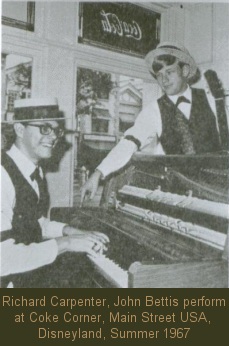|












| |


What happened next was every young act’s dream. The
Richard Carpenter Trio had reached the finals of the prestigious amateur talent
contest ‘The Battle of the Bands’ at the Hollywood Bowl on June 24, 1966 and
triumphed. Iced tea was the favorite drink of Karen and Richard, and he composed
an ambitious instrumental with that title that was a showcase for Wes Jacob’s
tuba and Karen’s drumming. The group’s originality impressed the judges.
 Their
other song was a dazzling instrumental version of the bossa nova classic
The Girl From Ipanema, popularized by Astrud Gilberto with Stan Getz. A
multi-time signature rendition arranged by Richard drew applause from the judges
– and the trio took three awards including best combo, outstanding
instrumentalist (Richard), and the sweepstakes trophy for the highest score of
any act in the whole contest. Their victories were the talk of the Hollywood
Bowl. Their
other song was a dazzling instrumental version of the bossa nova classic
The Girl From Ipanema, popularized by Astrud Gilberto with Stan Getz. A
multi-time signature rendition arranged by Richard drew applause from the judges
– and the trio took three awards including best combo, outstanding
instrumentalist (Richard), and the sweepstakes trophy for the highest score of
any act in the whole contest. Their victories were the talk of the Hollywood
Bowl.
Reviewing the show in the Los Angeles Times,
Leonard Feather wrote: “The musical surprise of the evening was the Trio of
Richard Carpenter, a remarkably original soloist who won awards as the best
instrumentalist and leader of the best combo. Flanking his piano were Karen
Carpenter, his talented sixteen year old sister, at the drums, and bassist Wes
Jacobs who doubled amusingly and confidently on tuba.”
As Richard walked with Karen to the parking lot, a
man walked over to congratulate them and inquire whether they might like to make
test records. “I was nineteen, smug, full of myself, and we’d just won,” Richard
says. “I told him we already had a contract. He said to give him a call if
things changed, and gave me his card.” This card gave his name as Neely Plumb,
the prominent West Coast manager of pop with the giant RCA Records. Pulling his
foot from his mouth, Richard gathered himself quickly and said that actually his
sister was signed to a small company as a singer, but the trio was not. (Richard
was signed only as a songwriter to Light-Up Music, the publishing arm of Magic
Lamp Records.) Plumb said he was interested in their instrumental sound, and a
test at RCA followed. It transpired that Plumb wanted to develop a ‘rock tuba’
sound by emphasizing the uniqueness of Wes Jacobs. In September, the trio signed
with RCA and quickly cut eleven tracks, including Strangers in the Night,
the Beatles’ Every Little Thing, and an original, Flat Baroque
which eventually became a popular Carpenters track. But the RCA committee voted
against them all. With psychedelia dawning, they saw no commercial potential in
a jazzy trio. Losing confidence in getting themselves established with RCA,
Richard, Karen and Wes accepted the company’s offer of a few hundred dollars to
end the contract.
Before long the trio had split up. Jacobs decided
that his way forward was in concert music, and left to pursue that aim and study
at Julliard. The two Carpenters went back to their respective studies.
 One of Richard’s fellow students at the time was
John Bettis. The two would form a lasting friendship and together they would
later write several of the Carpenters’ biggest hits. One of Richard’s fellow students at the time was
John Bettis. The two would form a lasting friendship and together they would
later write several of the Carpenters’ biggest hits.
Their first experience of working together
professionally was less successful, however. They both took a job at Coke Corner
on Disneyland’s Main Street U.S.A. There, routinely deviating from the
selections of turn-of-the-century tunes they were asked to perform, the pair
were sacked after four months.
Previous Page ....
Next Page |
